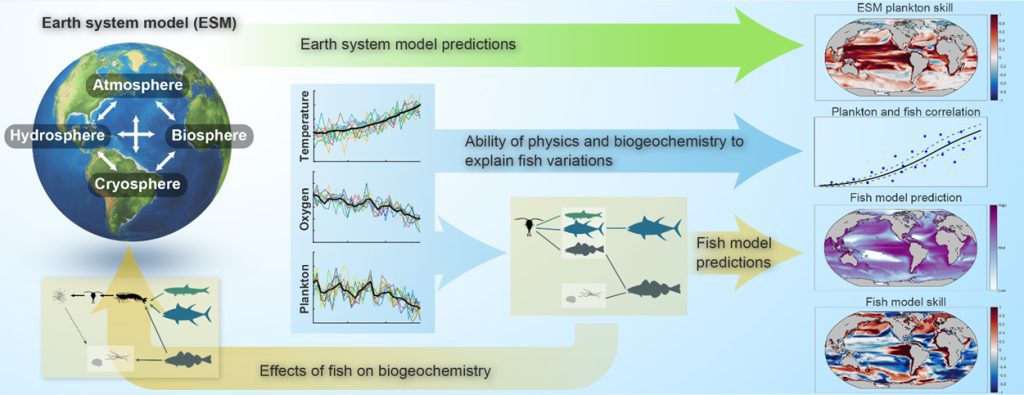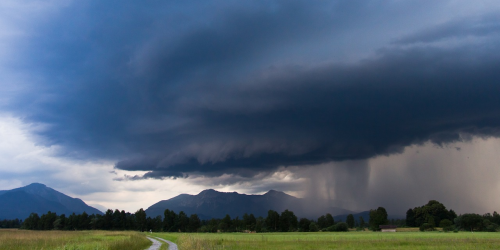In collaboration with the NOAA Fisheries Office of Science and Technology (OST), CPO’s Modeling, Analysis, Predictions, and Projections (MAPP) Program is announcing 13 new 3-year projects starting in Fiscal Year 2020 (FY20) that aim to improve the modeling of how climate impacts the predictability of fisheries and other living marine resources across timescales. The competitively selected projects total $5,989,039, including $3,298,155 in grants and $2,690,884 in other awards.

From warming and acidifying water to rising seas, changing climate and oceans are affecting the nation’s valuable living marine resources and the people, businesses, and communities that depend on them. There is much at risk in the United States—commercial and recreational fishing and the seafood industry annually contribute approximately $212 billion in sales, add $100 billion to the gross domestic product, and support over 1.7 million full- and part-time jobs. Healthy coastal habitats help defend coastal communities from storms and inundation and provide the foundation for tourism and recreation-based economies in many coastal communities.
Climate-related research is needed to fulfill NOAA Fisheries statutory mandates and provide decision-makers with the information they need to reduce climate impacts on our living marine resources (LMR) and dependent communities, and increase resilience with changing climate and ocean conditions. To meet these needs, these 13 new projects will strengthen climate-related science capacity as it relates to marine ecosystems regionally and nationally. This new set of projects represents a significant collaboration between the NOAA Fisheries and Research line offices, and supports the application of modeling and other NOAA Research science to NOAA Fisheries applications. A Task Force formed of the funded investigators will be led by Colleen Petrik (TAMU), Charlie Stock (NOAA GFDL), Mike Jacox (NOAA SWFSC and ESRL PSL), and Juliana Dias (NOAA PSL). The Task Force will focus on creating collaborations between the projects and entraining the science being conducted under this funding initiative into NOAA. Building this research and understanding into our models and prediction systems promises to provide critical information to improve fisheries management practices.
The 13 new projects funded by the MAPP Program in partnership with NOAA FIsheries OST in FY 2020 to improve the modeling of how climate impacts the predictability of fisheries and other living marine resources across timescales are:
- Understanding the variability and projecting future changes of biogeochemistry in the California Current upwelling system
The main goal of this project is to understand and quantify the variability of the physical mechanisms that drive changes in the biogeochemistry of the California Current upwelling system in response to anthropogenic climate change.- PI: Mercedes Pozo Buil, University of California, Santa Cruz
- Co-PIs: Micahel Jacox, NOAA Southwest Fisheries Science Center; Desiree Tommasi, University of California, Santa Cruz; Jerome Fiechter, University of California, Santa Cruz; Steven Bograd, NOAA Southwest Fisheries Science Center; Ryan Rykaczewski, NOAA Pacific Islands Fisheries Science Center
- Future climate impacts on the pelagic and coastal fisheries of Hawai‘i
This project is an end-to-end research-based approach to identify the role of interannual-to-decadal variability and climate change forcing on Hawaiian fisheries. By utilizing two fishery models, this project will broaden CPO’s success by quantitatively addressing the climate impacts on marine health, fishery productivity, and the sustainability and resilience of the marine ecosystem for the critical fisheries of Hawai‘i.- PI: Brian Powell, University of Hawai‘i at Mānoa
- Co-PIs: Ryan Rykaczewski, NOAA Inouye Regional Center, NMFS/PIFSC/ESD; Mariska Weijerman, NOAA Inouye Regional Center, NMFS/PIFSC/ESD; Phoebe A. Woodworth-Jefcoats, NOAA Inouye Regional Center, NMFS/PIFSC/ESD; Malte Stuecker, University of Hawai’i at Mānoa; Tobias Friedrich, University of Hawai’i at Mānoa
- Improving the utility of global climate forecasts for regional fisheries applications
This project will quantify the dependence of forecast skill for LMR-relevant variables in the California Current large marine ecosystem (CCLME) on the climate state and document mechanistic links between short-lead forecast skill (e.g., in the tropics) and longer-lead forecast skill in the CCLME. Key elements of the work plan are: to (1) evaluate subseasonal-to-seasonal (S2S) reforecasts from the S2S, SubX, and NMME archives for ocean variables identified as highly impactful on LMR in the CCLME; (2) quantify hypothesized relationships between short- and long-lead forecast skill, with the aim of using short-lead metrics to diagnose whether forecasts are likely to be skillful at longer leads and (3) compare skill enhancements related to these new metrics with skill improvements enabled by dynamically downscaled regional forecasts. The downscaled forecasts and the high-resolution regional ocean reanalysis outputs needed for skill evaluation are available from prior projects.- PIs: Michael Jacox, NOAA Southwest Fisheries Science Center; Michael Alexander, NOAA Physical Sciences Laboratory
- Co-PIs: Juliana Dias, NOAA Physical Sciences Laboratory; Desiree Tommasi, University of California, Santa Cruz
- Potential impacts of climate variability and change on the recent declines in coastal species along the U.S. Gulf and South Atlantic Bight
The primary objective of this project is to elucidate potential large-scale climate drivers of plankton biomass and range shifts–and their combined influences–for a suite of coastal pelagic species in the Gulf of Mexico and South Atlantic Bight.- PIs: Sang-Ki Lee, NOAA Atlantic Oceanographic and Meteorological Laboratory; Mandy Karnauskas, NOAA Southeast Fisheries Science Center; Kevin Craig, NOAA Southeast Fisheries Science Center
- Co-PI: Fabian Gomez, Pontifical Catholic University del Valparaiso
- Incorporating fish in Earth system predictions
This project will help extend Earth system models predictions to include fish. To do so, it will couple an existing Fisheries Size and Functional Type model (FEISTY) to the MOM6 ocean general circulation model, thereby enabling direct simulation and prediction of potential fish catch, fish distributions, and food web structure in the NOAA Geophysical Fluid Dynamics Laboratory and National Center for Atmospheric Research Earth-system models.- Lead-PI: Matthew Long, National Center for Atmospheric Research
- PIs: Colleen Petrik, Texas A&M University; Samantha Siedlecki, UCONN
- Co-PI: Gokhan Danabasoglu, National Center for Atmospheric Research
- Mechanisms of U.S. West Coast climate variability and change in observations and models
This project will use observational data sets in conjunction with oceanic and coupled reanalysis products to identify the key dynamical processes underlying temperature variations along the United States West Coast and their extremes, and provide a baseline for evaluating the fidelity of state-of-the-art climate models in representing the full range of observed West Coast conditions.- PI: Antonietta Capotondi, NOAA NOAA Physical Sciences Laboratory
- Co-PI: Prashant D. Sardeshmukh, NOAA Physical Sciences Laboratory
- Towards the prediction of fisheries on seasonal to multiannual time scales
This project’s overarching task is to incorporate an offline fish model with the results of Earth system models run in initialized prediction mode to generate and assess model predictions. The project also includes simulation of large ensembles of seasonal to decadal scale predictions of the physical and biogeochemical variables of relevance to fish, which will then be used to force a mechanistic fish model, FEISTY.- Lead PI: Colleen Petrick, Texas A&M University
- Co-PIs: Samantha Siedlecki, University of Connecticut; Matthew Long, University Corporation for Atmospheric Research
- Unfunded Collaborators: Charles Stock, NOAA GFDL; Stephen Yeager, University Corporation for Atmospheric Research
- The role of biogeochemical processes in controlling LMR-relevant properties in an Eastern Bering Sea climate-to-fish modeling framework
This project will conduct a biogeochemical model intercomparison for the Bering Sea. This model intercomparison will couple four existing biogeochemical models, all with contrasting but equally justifiable representations of the lower trophic level dynamics of the Bering Sea, to an identical hydrodynamic model forced with historical atmospheric and lateral ocean boundary conditions.- Lead PI: Albert Hermann, University of Washington, Cooperative Institute for Climate, Ocean, and Ecosystem Studies
- Co-PIs: Kelly Kearney, University of Washington CICOES; Wei Cheng, University of Washington CICOES
- Unfunded Collaborators: Darren Pilcher, University of Washington CICOES; Kerim Aydin, University of Washington CICOES
- Validation of regional ocean model hindcasts for zooplankton biomass via comparisons with thirty years of field sampling data in a rapidly changing ecosystem
This project aims to evaluate the Bering 10K model output by comparing it to field observations of the zooplankton community.- Lead-PI: David Kimmel, NOAA Alaska Fisheries Science Center
- PIs: James Thorson, NOAA Alaska Fisheries Science Center; Darren Pilcher, NOAA Pacific Marine Environmental Laboratory
- Unfunded Collaborators: Kelly Kearney, NOAA Alaska Fisheries Science Center; Patrick Ressler, NOAA Alaska Fisheries Science Center
- Impact of climate variability on bottom water biogeochemistry in the context of demersal fisheries of the Northwest Atlantic shelf
This project will compile historical monitoring data focusing specifically on carbonate chemistry from publicly available databases that will allow researchers to leverage ongoing sampling programs such as the NOAA EcoMon and East Coast Ocean Acidification programs, Ocean Observatories Initiative service cruises, and Northeast Shelf Long-Term Ecological Research cruises.- PI: Jeannie Rheuban, Woods Hole Oceanographic Institution
- Co-PI: Ivan Lima, Woods Hole Oceanographic Institution; Zhaohui Aleck Wang, Woods Hole Oceanographic Institution
- The predictability of oxygen and its metabolic consequences for fisheries on decadal time scales
This project will examine the predictability of fisheries relevant environmental variables beyond sea surface temperature and chlorophyll, such as oxygen and related metabolic metrics, as well as potential limitations on fisheries that this metabolic index projects.- Lead-PI: Samantha Siedlecki, University of Connecticut
- PIs: Colleen Petrick, Texas A&M University; Matthew Long, University Corporation for Atmospheric Research
- Unfunded Collaborator: Vincent Saba, NOAA NMFS/GFDL





